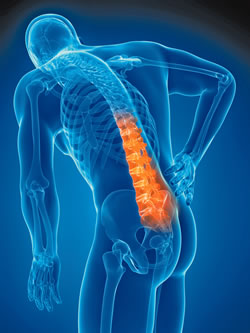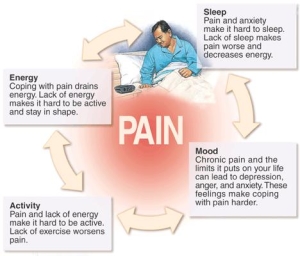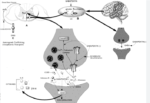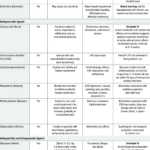If you’ve ever groaned, “Oh, my aching back!”, you are not alone. Back pain is one of the most common medical problems, affecting 8 out of 10 people at some point during their lives. Back pain can range from a dull, constant ache to a sudden, sharp pain. Acute back pain comes on suddenly and usually lasts from a few days to a few weeks. Back pain is called chronic if it lasts for more than three months.
Most back pain goes away on its own, though it may take awhile. Taking over-the-counter pain relievers and resting can help. However, staying in bed for more than 1 or 2 days can make it worse.
If your back pain is severe or doesn’t improve after three days, you should call your health care provider. You should also get medical attention if you have back pain following an injury.
Treatment for back pain depends on what kind of pain you have, and what is causing it. It may include hot or cold packs, exercise, medicines, injections, complementary treatments, and sometimes surgery.

What is Back Pain ?
Back pain is one of the most common medical problems in the United States. It might feel like a dull, constant ache or a sudden, sharp pain. Back pain can result from:
- An accident.
- A fall.
- Lifting something heavy.
- Changes that happen in the spine as you age.
- A disorder or medical condition.
Treatment depends on the cause and symptoms of your pain. You can do things to improve your health and lower your chance of developing chronic (long-lasting) back pain.
What are the symptoms of back pain?
Your back may hurt in one specific part or it may spread all over your back. It also can cause pain in other areas, such as the:
- Buttocks.
- Legs.
- Abdomen.
Depending on the type, cause, and location, your back pain may get worse when:
- Lifting and bending.
- Resting.
- Sitting.
- Standing.
It may come and go. You also may feel stiffness in the morning when you wake up, and the pain may get better as you move around.
You should see a doctor if your pain does not get better after a few weeks or if any of the following symptoms happen with your back pain:
- Numbness and tingling.
- Very bad back pain that does not get better with medication (see Treatment section).
- Back pain after a fall or injury.
- Back pain along with:
- Trouble urinating.
- Weakness, pain, or numbness in your legs.
- Fever.
- Weight loss that you did not intend.
What are the types of back pain?
You may feel back pain that happens suddenly and lasts a few days to a few weeks, or you may have back pain that lasts longer, such as 4 to 12 weeks or more.
Back pain can be acute (short term) or chronic (long term). It can feel like a sudden, sharp pain or a dull, constant ache.
Acute back pain lasts from a few days to a few weeks. It’s often caused by an accident, fall, or lifting something that’s too heavy. Acute back pain usually gets better on its own, without any treatment.
Chronic back pain lasts for more than 3 months. It’s much less common than acute back pain. Most chronic back pain can be treated without surgery.
Who gets back pain?
Anyone can have back pain. You may be more likely to have back pain because of the following:
- Fitness level: Back pain is more common among people who are out of shape. You may also get back pain if you exercise too hard after not being active for a while.
- Obesity: If you are overweight or obese, it can put stress on the back and cause pain.
- Job-related risk factors: Jobs that require heavy lifting, pushing, pulling, or twisting can injure the back. A desk job may also play a role, especially if you slouch or sit all day in an uncomfortable chair.
- Age: You may have more back pain as you get older, particularly after you turn 45.
- Family history: Your genes play a role in some disorders that cause back pain.
What causes back pain?
Many different things may cause back pain, such as physical problems with the back. For example:
- Sprain.
- Strain.
- Herniated or “slipped” disc.
- Broken bones.
Other medical conditions can cause back pain, including:
- Arthritis.
- Osteoporosis.
- Kidney stones or infections.
- Tumors.
How is back pain diagnosed?
Doctors use many tools to help figure out the possible cause for your back pain, which helps them know how best to treat it.
Your doctor may ask questions about your medical and family history to see if an injury or other medical condition is the source for the back pain. The doctor may ask many questions about your pain, such as:
- When it started.
- Where it hurts most.
- If anything makes it worse or better.
Your doctor may also do a physical exam and have you bend or lift your legs to see how moving affects the pain, and test your reflexes and muscle strength.
Sometimes, you may need more tests such as:
- X-rays.
- Other imaging tests.
- Bone scans.
- Blood tests.
How is back pain treated?
Doctors treat back pain with medications, other treatments, and surgery. Medications may help relieve pain or help tense muscles relax.
In addition, your doctor may tell you to:
- Use cold packs to help lower some back pain and hot packs to increase blood flow and help you heal.
- Limit activities or exercise that cause pain or make it worse, but do not lay down all day. Slowly increase physical activity as you can.
- Get physical therapy to help strengthen the muscles that support the back.
- Move your body the right way when going about your day, especially when you lift, push, or pull something.
- Practice healthy habits such as exercising, getting regular sleep, eating a healthy diet, and quitting smoking.
Your doctor may recommend surgery if all other treatments tried have not lowered your back pain. However, surgery is not right for everyone, and your doctor will help you decide if it may be best for you.
Who treats back pain?
Different types of health care providers treat back pain, depending on the cause:
- Pain specialists, who have training in diagnosing and treating different types of pain.
- Family or primary care doctors.
- Orthopaedists, who treat and perform surgery for bone and joint diseases.
- Neurologists, who treat disorders and diseases of the spine, brain, and nerves.
- Neurosurgeons, who perform surgery for disorders and diseases of spine, brain, and nerves.
- Rheumatologists, who specialize in treating musculoskeletal diseases and autoimmune disorders.
- Physical therapists, who specialize in movement and strengthening muscles.
Living with back pain
Living with back pain can be hard; however, most people feel better within 6 weeks. Remember to follow your doctor’s directions. These tips may make it easier for you to manage your pain and recover:
- Add exercises slowly and talk to your doctor about the types of exercises that are best for you or those that you should not do.
- When sitting for a long time, get up, move around, and switch positions frequently.
- Wear shoes that feel good and that have a low heel.
- When driving a long way, try using support behind your back, and stop frequently to stand up and walk around.
- Sleep on your side, and place a small pillow between your knees. If you tend to sleep on your back, place a pillow under your knees. If possible, try to avoid sleeping on your stomach.
- Limit the amount you carry. Instead, make a few extra trips to avoid carrying too much weight.

Can I prevent back pain?
One of the best ways to prevent back pain is to keep your back muscles strong. Follow these steps to help protect your back and prevent back pain:
- Do back-strengthening and stretching exercises at least 2 days a week.
- Stand and sit up straight.
- Avoid heavy lifting. If you do lift something heavy, bend your knees and keep your back straight. This way, your leg muscles will do most of the work.
- Get active and eat a balanced diet. Being overweight can strain your back. Getting active and heating healthy can help you stay at a healthy weight.
You may be able to prevent back pain that happens because of overuse or moving the wrong way. The following tips may help:
- Get regular exercise that keeps your back muscles strong. Exercises that increase balance and strength can lower your risk of falling and injuring your back or breaking bones. Your doctor may recommend that you try tai chi or yoga.
- Eat a healthy diet with enough calcium and vitamin D, which help keep your spine strong.
- Maintain a healthy weight to avoid stress and strain on your back.
- Sit up straight. Try to support your back when sitting or standing.
- If you have to lift something heavy, use your leg and stomach muscles, not your back.
- Focus on good posture.
- Try not to slouch when standing and sitting.
- Sit up straight with your back against the back of your chair and your feet flat on the floor. If possible, keep your knees slightly higher than your hips.
- Stand tall with your head up and shoulders back.
- If you can, switch between standing and sitting so you aren’t in the same position for too long.
- Healthy Habits
Healthy Habits for Preventing Back Pain

Watch your weight.
Staying at a healthy weight lowers your risk of back pain. If you are overweight, losing weight in a healthy way can reduce the strain on your back.
Get enough calcium and vitamin D.
Getting enough calcium and vitamin D can help keep your bones strong and prevent osteoporosis. Osteoporosis makes your bones weaker and more likely to fracture (break).
Spine fractures from osteoporosis are a leading cause of back pain.
What You Can Do About Your Back Pain
Avoid bed rest. Studies show that lying down too much can slow recovery and raise the pain.
“Over the last 25 years or so, probably the one thing we’ve learned definitively about back pain and bed rest is that is not OK,” says William Lauretti, DC, an associate professor at New York Chiropractic College and a spokesperson for the American Chiropractic Association. Instead, “you want to be as active as you can be with your back pain.”
Move. You may not want to move when you’re in pain, but it’s important to do as much as you can handle.
Robertson says most back pain isn’t serious, even if it may be very painful. “So not being afraid of motion and continuing to move despite the pain is something that’s really important,” he says. Walking is a good choice you can do on your own. You also can work with a physical therapist to learn how to spot dangerous levels of pain and which moves are best for you.
Keep good posture. Pay attention to the way you hold your back when you sit, stand, walk, sleep, or do day-to-day activities. Good posture is when all the bones in your spine are correctly aligned. Poor posture can leave your back stiff and tense. This often to leads to back pain.
Lauretti offers these tips on posture:
- Don’t sit up in your bed hunched over your laptop. That’s a surefire recipe for back pain over time.
- If you must sit for a long time, use cushioned chairs. Hard seats won’t support your back and may prevent you from sitting up straight.
- Use a comfortable desk and chair if you need them while working.
Here are some general tips to maintain good posture:
- Keep your feet shoulder-width apart.
- Tuck your stomach in when you’re standing.
- If you’re standing for too long, regularly shift your weight from one foot to the other and from your toes to heels.
- Roll your shoulders back.
- Let your arms hang naturally on the sides of your body.
Sleep smart. The ideal bed, Lauretti says, is one that’s “comfortable for you.” As for the best sleep posture, he says on your side or back is easier on your back than sleeping on your belly. If you’re face down, your head will be turned all night so you can breathe, which can lead to neck pain.
Bhamgara says tucking a pillow between her legs to help align her hips lessens her back pain.
Relax. Back pain can be linked to stress, tension, and other non-physical problems, Robertson says. Massages and acupuncture may help loosen muscles. Yoga, meditation, and other mindfulness practices may help lift your mood, stretch your muscles, and make you relax so you can better manage your back pain.
Bhamgara says mediation made her feel alive, especially when her back pain made it painful to move freely.
“I would think about healing every inch of my body,” she says. “There were times I would imagine myself walking in a park with my headphones on and just dancing! That brought me life.”
What is Back Pain Prescriptions ?
There are multiple categories and types of medications for back pain; depending on how severe your symptoms are, how long you’ve had them, where they’re located, and what side effects you can tolerate.
Anti-Inflammatory Medications
The first medication of choice for most people with back pain is an over-the-counter, nonsteroidal anti-inflammatory drug (NSAID), such as ibuprofen (Motrin) or naproxen (Aleve), says Jae Jung, MD, assistant professor in the department of orthopaedics at the David Geffen School of Medicine at the University of California-Los Angeles. “These are considered milder analgesics, and would be the first tier of treatment,” he says.
Tylenol (acetaminophen), while not a nonsteroidal anti-inflammatory drug, is also a common over-the-counter pain reliever used to treat back pain.
There are also prescription-only NSAIDs, such as celecoxib (Celebrex), diclofenac (Voltaren), meloxicam (Mobic), and nabumetone (Relafen).
Although these medications are on the milder side of the pain relief spectrum, they still come with side effects — especially if you take them at higher doses for a long time. NSAID side effects can include gastrointestinal problems, ulcers, and kidney damage, while acetaminophen can affect the liver.
Other topical treatments that can be used for pain contain ingredients such as capsaicin, camphor, menthol, and eucalyptus oil.
Muscle Relaxants
If over-the-counter pain relievers or prescription NSAIDs are not relieving your back pain, your doctor may suggest adding a muscle relaxant. These medications include:
- Cyclobenzaprine (Flexeril)
- Tizanidine (Zanaflex)
- Baclofen (Lioresal)
- Carisoprodol (Soma)
There are many brand names in the same category, says Jung. They help relieve the muscle spasms that are causing your back pain.
Muscle relaxants may be particularly useful for acute injuries (such as straining your back playing basketball), says Jung. For example, carisoprodol (Soma) significantly reduced back pain and improved function after three days of treatment, according to the results of clinical trials presented at the American Academy of Pain Medicine’s 2010 annual meeting.
Most of these drugs have similar side effects, with drowsiness being the most common. “They can be quite sedating,” Jung says. “If you’ve never tried them before, don’t operate heavy machinery or drive until you know how they affect you. I usually start patients on these at night to see how they react.”
Opioids
For some patients, NSAIDs and muscle relaxants are not enough. People with long-lasting, chronic back pain, particularly after multiple surgeries, are sometimes prescribed opioid or narcotic medications. In fact, one study showed that as many as 70% of back pain patients receive opioids, which some experts suggest is probably too many.
These drugs act on pain receptors in the brain and nerve cells to alleviate pain. Jung says there are milder, shorter-acting versions, such as Vicodin (acetaminophen and hydrocodone) and Tylenol with codeine — which is what most people begin with — as well as stronger drugs like morphine.
Their most common side effects include:
- Drowsiness and sedation
- Constipation
- Risk of dependency
- Allergic reactions, such as hives and itching
There’s also a step between NSAIDs and muscle relaxants and a more classic opioid or narcotic drugs. Tramadol (brand names Rybix, Ryzolt or Ultram) also acts on the opioid receptors in the brain, but it is weaker compared to morphine or hydrocodone, so it’s not regulated like a controlled substance, says Jung. “So it’s a milder approach and patients who don’t want to move on to narcotics often think that’s a good option, he says.
Like anti-inflammatory drugs, corticosteroids can also relieve inflammation and alleviate back pain. They can be taken either orally or via injection into your back.
“Certain antidepressants, like Cymbalta [duloxetine], and anti-seizure medications, like Lyrica [pregabalin] or Neurontin [gabapentin] have been shown to be beneficial for nerve symptoms,” explains Jung. Another class of antidepressants, known as tricyclics — including amitriptyline (Elavil) and nortriptyline (Pamelor) — also may be prescribed to manage chronic back pain. “So if you have a pinched nerve in the back, with pain that radiates down your leg, one of these medications can be very effective to quiet the nerve irritation and relieve the burning pain, numbness and tingling that are often involved.”
Although they vary somewhat, the antidepressants and anti-seizure medications used to treat back pain have a fairly similar lists of side effects. The more common side effects of these medications include:
- Headaches
- Nausea
- Constipation
- Diarrhea
- Insomnia
- Sexual side effects
- Fatigue
Call your doctor if you experience any of these more serious side effects:
- Allergic reactions such as hives, itching, and swelling
- Changes in heart rhythm
- Seizures
- Confusion or hallucinations
- Inability to sit still
- Aggression, mood swings, or other significant behavior changes
- Thoughts of suicide
No matter which medications you take for your back pain, Jung says that they should not be your only mode of relief.
“If a patient has only had pain for a few days, I don’t want to blast them with chemicals — they may just recover on their own. With pain that’s lasted three months or more, we try to use more than one medication to alleviate their pain,” he says. “We have to get patients involved in their care. Physical therapy should be used early on. Teaching the patient to exercise, in combination with your other therapies, is a lot better than just giving them pills to take.”
Back Pain Background
Back pain is a particularly prominent issue in adults and can be caused by a number of different factors. As you may know if you are suffering from back pains, it can be an extremely debilitating health issue.
Healthy Habits
The majority of back pain originates from sprains or strains caused by movements which place the back’s muscles and tendons in a stressed position. In these cases, the most effective treatment is simple rest and time. In addition , applying ice to the injured area and taking anti-inflammatory medication can aid in lessening the pain back to a more manageable level.
Most of the time, medical attention and surgery are not necessary and the ailment will improve with rest. However , more serious conditions such as herniated discs may require surgery and or physical therapy. If the pain in back persists, it is always a good idea to consult a physician to diagnose the potential issues you may be facing.
Back pain can be a recurring injury and even simply movements that involve twisting or bending can bring the pain back. Staying active and exercising often can help in preventing these injuries. Maintaining a strong core and lower back reduces the risk of back pain exponentially.
Injuries most commonly occur in the muscles, tendons and ligaments in the back in the form of strains and sprains. These common ailments are not serious and will heal on their own with rest. However , injuries in the bones or nerves of the back can be a much more serious issue.
Tears in discs for instance can cause the annulus fibrosis to bulge out which can cause acute pain and inflammation. These injuries require immediate medical attention and many times require surgery.
Maintaining proper posture throughout the day, exercising frequently and using proper form when lifting heavy objects are the three most effective ways to avoid injuring your back.
In the event of an injury to your back, apply ice to the injured area immediately. After 48 hours, you may want to apply heat packs to the injured area which will relax injured tissue, alternating ice and heat therapy from then forward.
Acute back pain often lasts four to six weeks, while chronic back pain can be a long-term annoyance sometimes lasting throughout life in certain cases. Taking the preventative actions to avoid back pain and utilizing the aforementioned treatments in the case of an injury are the best ways to avoid experiencing long-lasting, chronic back pain.
Pain Medications, Pain Relief, and Pain Management






